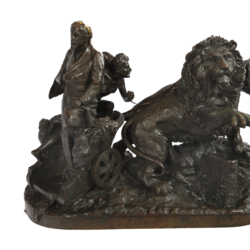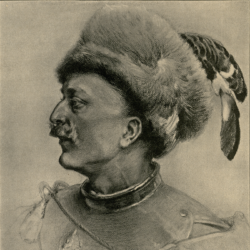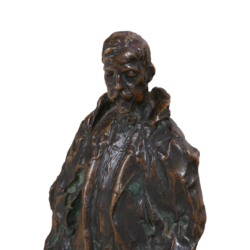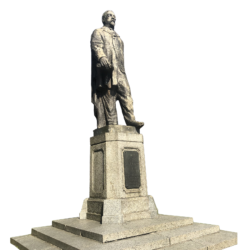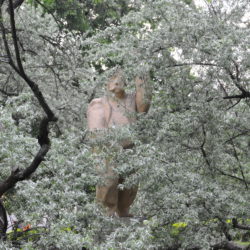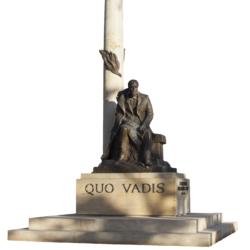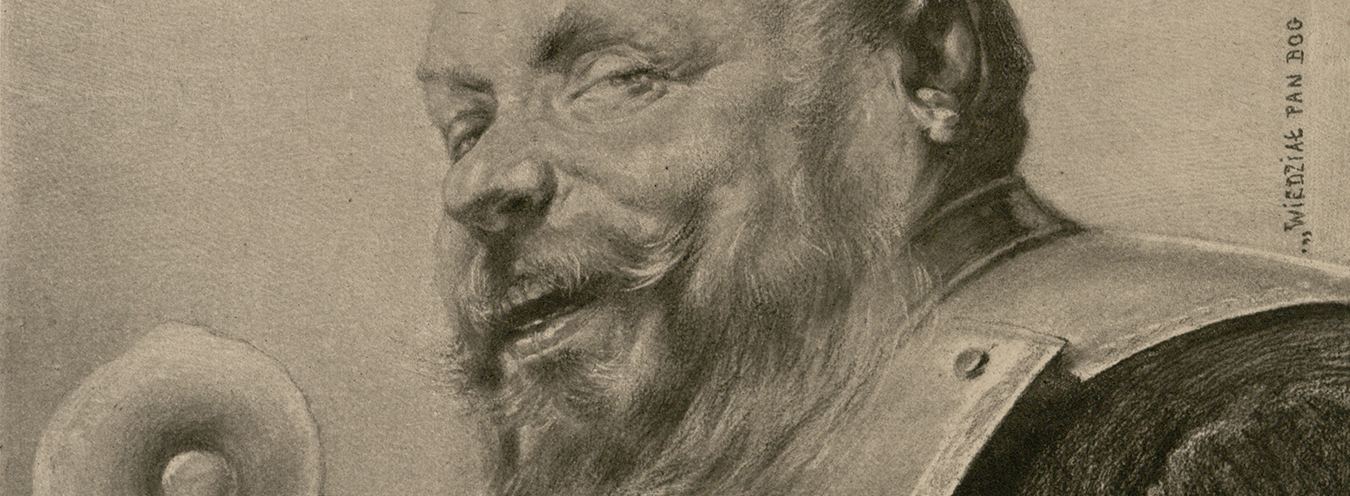
Zagłoba in Warsaw
Let us return for a minute to the conversation between General Cymbarewicz and Chairman Mikoyan. Cymbarewicz held the position between 1952 and 1956, so the talk must have taken place in the 1950s, already after the inauguration of the plaque depicting the mock-epic wrestle of Onufry Zagłoba with monkeys, authored by artist Józefa Wnukowa, at the foot of the Kazanowski Palace. The artwork was created between 1949 and 1952 on the less prominent side of the Vistula escarpment and Mariensztat, “over the last of the remaining palace bulwarks.”[1] The humorous plaque got its semi-official life of its own. It was – and still is – described good-naturedly as, among others, a continuation of the pre-war initiative of putting up plaques for fictional characters of The Doll by Bolesław Prus or marking the fictional tomb of Roch Kowalski (a character of The Deluge by Sienkiewicz) at a church in Ratuszowa Street. The plaque has also been dubbed “a surprisingly friendly face of Socialist Realism.”[2] Interestingly, there were two more monuments to Zagłoba, a representative of lesser nobility, in the capital of the Polish People’s Republic with its anti-nobility ideals, and in quite peculiar locations, too. “The Palace of Culture and Science has a little-known statue of one of the Trilogy characters, Zagłoba, portrayed in his fight with monkeys,” wrote Małgorzata Trzeciak in the early 1990s.[3] It was about that time that the sculpture left the Młoda Gwardia cinema hall it had occupied for years; the fact that it was a favorite with children meant nothing in the face of the avalanche of system changes, and Zagłoba was removed once this part of the building was modified to accommodate the BAS shopping center.[4] As revealed by Waldemar Baraniewski, the redecoration program for the Palace – even in the Stalinist era – was imprecise and allowed for a number of different options as long as the primary objective was the legitimization of the communist authority.[5] I believe this fact accounts for the appearance of Zagłoba fighting apes in the first place, not to mention an obvious attempt at making the hall space more attractive and visitor-friendly (other Palace halls also came to display interesting items, often linked to the institutions adjacent to them, such as a dinosaur skeleton model at the entrance to the Museum of Evolution). Yet another statue, this time without the accompanying monkeys, can unsurprisingly be found close to Zagłoba Street in the Warsaw district of Ursus, Niedźwiadek neighborhood. That particular Zagłoba, unsightly and even more caricatured than his grotesque depiction in the Trilogy itself, often has a tire put on his neck. Once, he even sported a Michael Jordan 23 Chicago Bulls T-shirt painted on his chest.[6] At present, the space around the statue is overgrown with greenery. In the words of a Warsaw blogger: “Is it a bear? Or is it Zagłoba? He looks a bit like a guy relieving himself behind the bushes.”[7]
The capital city was a place where it was much easier to put up a plaque or a monument to Sienkiewicz’s literary characters (especially comic, even cartoonish ones) than to their originator. Warsaw tributes to the writer included naming a primary school in the Praga district after him in 1961, which involved an unveiling of unveiling his bust, sculpted by Franciszek Strynkiewicz; founding a commemorative plaque by the academic community on the University of Warsaw campus five years later; and turning the writer’s burial crypt at St. John’s Archcathedral in Warsaw into a memorial center as the 20th century advanced.[8] All these forms of remembrance are placed in the peripheries of public vision (on the outskirts of the city, off a main street or city sightseeing trail, usually hidden inside a building or in a yard). Even though there seems to be an underlying reason for the location of every single memorial, all of them can be said to reflect – at least, to a certain degree – the intended reception and interpretations of Sienkiewicz’s oeuvre endorsed by the authorities (with a possible exception of the anti-German slant).
Zagłoba’s statue in Ursus can be justified with the proximity of a street named after this fictional character. One might assume that the naming itself, which took place in 1977, inscribed itself quite well within the tendency to situate Sienkiewicz memorials in the capital’s low-key, secluded places. In this case, however, the historical context is much more complicated.
Przypisy
- S. Ciepłowski, Napisy pamiątkowe w Warszawie XVII–XX w. [Memorial plaques in Warsaw, 17th–20th c.], Warsaw 1987, p. 36; Z. Stępiński, Gawędy warszawskiego architekta [The stories of a Warsaw architekt], Warsaw 1984, p. 65; trans. J. M.
- http://forum.gazeta.pl/forum/w,437,12540907,12540907,tu_pan_Zagloba_walczyl_z_Malpami.html, accessed on February 1, 2017; trans. J. M.
- M. Trzeciak, “Henryk Sienkiewicz,” in Warszawa pozytywistów [The Warsaw of positivists], edited by J. Kulczycka-Saloni, E. Ihnatowicz, Warsaw 1992, pp. 160–161; trans. J. M.
- http://warszawa.wyborcza.pl/warszawa/1,34862,20350630,demontuja-neony-kinoteki-na-palacu-kultury-w-sierpniu-zaswieca.html?disableRedirects=true, accessed on February 1, 2017. The Zagłoba sculpture was taken away at the same time as the Socialist-Realist Przyjaźń [Friendship] by Alina Szapocznikow. The dismantling report of 16 May 1992 was later found and perused by Katarzyna Bielas and Dorota Jarecka. The artworks mentioned there include the Zagłoba statue, but I found no evidence of anyone trying to track it down. Bielas and Jarecka focused entirely on the fate of Przyjaźń. See K. Bielas, D. Jarecka, “Była tu jakaś «Przyjaźń»?” [Has there been any “Friendship”?], in Jako dowód i wyraz przyjaźni. Reportaże o Pałacu Kultury [In evidence and expression of friendship: Reportages on the Palace of Culture], edited by M. Budzińska, M. Sznajderman, Wołowiec 2015, p. 272 (initially published in Gazeta Wyborcza of September 13, 1998).
- W. Baraniewski, Pałac w Warszawie [A palace in Warsaw], Warsaw 2014, p. 53 and following.
- The above information courtesy of a long-time resident of the Niedźwiadek neighborhood in Ursus.
- http://varszavka.blogspot.com/2016/09/pomnik-zagoby-na-osiedlu-ursus.html, accessed on January 30, 2017; trans. J. M.
- S. Ciepłowski, op. cit., p. 107; M. Trzeciak, op. cit., pp. 160–161; http://www.sp127.edu.pl//historia, accessed on September 17, 2017.

